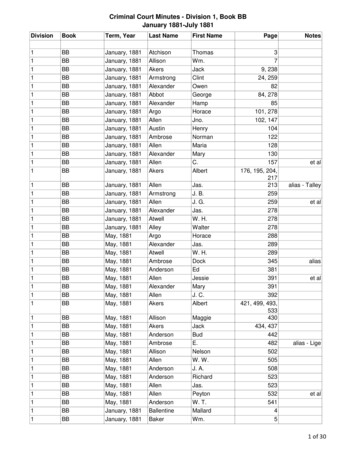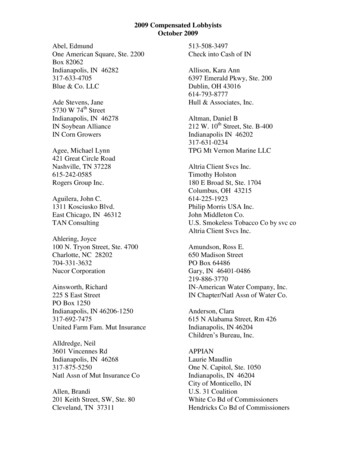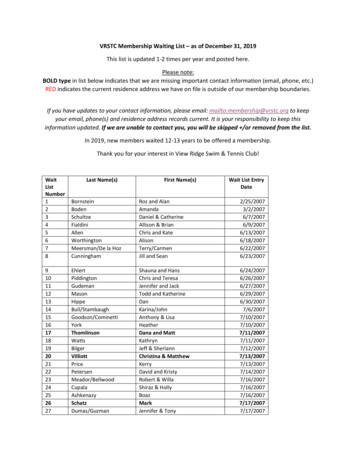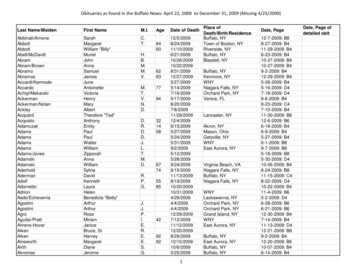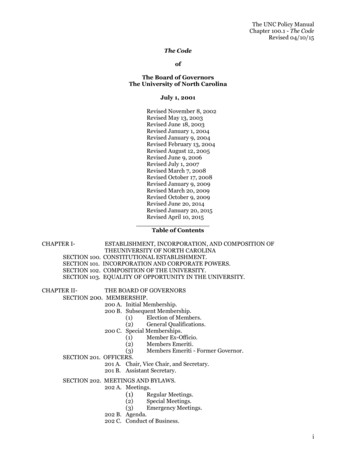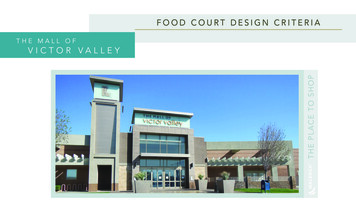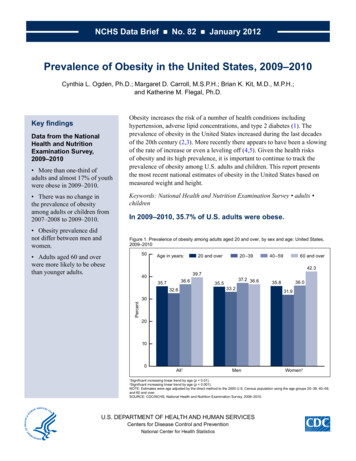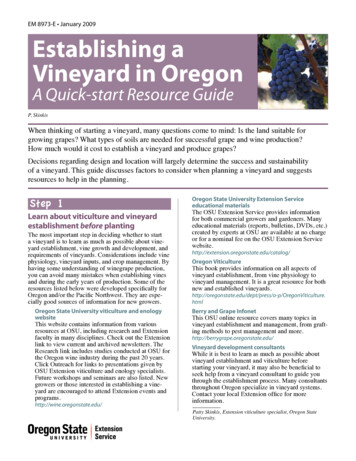
Transcription
EM 8973-E January 2009Establishing aVineyard in OregonA Quick-start Resource GuideP. SkinkisWhen thinking of starting a vineyard, many questions come to mind: Is the land suitable forgrowing grapes? What types of soils are needed for successful grape and wine production?How much would it cost to establish a vineyard and produce grapes?Decisions regarding design and location will largely determine the success and sustainabilityof a vineyard. This guide discusses factors to consider when planning a vineyard and suggestsresources to help in the planning.Step 1Learn about viticulture and vineyardestablishment before plantingThe most important step in deciding whether to starta vineyard is to learn as much as possible about vineyard establishment, vine growth and development, andrequirements of vineyards. Considerations include vinephysiology, vineyard inputs, and crop management. Byhaving some understanding of winegrape production,you can avoid many mistakes when establishing vinesand during the early years of production. Some of theresources listed below were developed specifically forOregon and/or the Pacific Northwest. They are especially good sources of information for new growers.Oregon State University viticulture and enologywebsiteThis website contains information from variousresources at OSU, including research and Extensionfaculty in many disciplines. Check out the E xtensionlink to view current and archived newsletters. TheResearch link includes studies conducted at OSU forthe Oregon wine industry during the past 20 years.Click Outreach for links to presentations given byOSU Extension viticulture and enology specialists.Future workshops and seminars are also listed. Newgrowers or those interested in establishing a vineyard are encouraged to attend Extension events andprograms.http://wine.oregonstate.edu/Oregon State University Extension Serviceeducational materialsThe OSU Extension Service provides informationfor both commercial growers and gardeners. Manyeducational materials (reports, bulletins, DVDs, etc.)created by experts at OSU are available at no chargeor for a nominal fee on the OSU Extension talog/Oregon ViticultureThis book provides information on all aspects ofvineyard establishment, from vine physiology tovineyard management. It is a great resource for bothnew and established egonViticulture.htmlBerry and Grape InfonetThis OSU online resource covers many topics invineyard establishment and management, from grafting methods to pest management and more.http://berrygrape.oregonstate.edu/Vineyard development consultantsWhile it is best to learn as much as possible aboutvineyard establishment and viticulture beforestarting your vineyard, it may also be beneficial toseek help from a vineyard consultant to guide youthrough the establishment process. Many consultantsthroughout Oregon specialize in vineyard systems.Contact your local Extension office for moreinformation.Patty Skinkis, Extension viticulture specialist, O regon State University.
Marketing and locationStep 2It is important to locate your vineyard in an area whereyou can produce a consistent crop of high-qualitygrapes. However, an equally important factor is proximity to a viable market. You want to be in an area thatfacilitates sale of your fruit or marketing it to wineries.Specified regions in the United States are known asAmerican Viticultural Areas (AVA). Wineries may wishto obtain fruit from a particular AVA and label it fordistinction. Furthermore, locating within a specific AVAcan improve marketing of wine if you plan a winery.American Viticultural Areas are under federal regulation (Code of Federal Regulations Title 27, Part 9).U.S. Geological Survey AVA mapsTo determine boundaries of AVAs or find outwhether your land lies within an AVA, you cansearch maps that delineate these areas.Understand vineyard economicsand develop a business planLike any agribusiness based on perennial crops, vineyard establishment involves substantial cost. In somecases, the cost of establishing and maintaining grapevines is higher than that for other perennial crops due tothe need for a trellis system and the use of manual laborfor many vineyard establishment and production tasks.Status of the Oregon wine industryOregon Vineyard and Winery ReportPublished by the National Agricultural StatisticsService (NASS, U.S. Department of Agriculture),this report provides historical information on grapecultivars grown in Oregon, yields, prices for harvested fruit, and production statistics.http://www.nass.usda.gov/Statistics by State/Oregon/Publications/Vineyard and Bureau of Alcohol, Tobacco, and Firearmsfrequently asked questions: Viticultural areasThis website contains more information on AVAsand related ne.htmEconomics of vineyard establishmentIt is important to consider the establishment and development costs associated with a vineyard. A number ofresources are available to help assess these costs.A Grower’s TEAMThis online economics workbook is one of the besttools for assessing the costs of vineyard establishment. Developed by economics and Extensionfaculty at Oregon State University, this program isavailable online at no charge. If you need help learning to use the software, OSU Extension holds training sessions annually. Contact your local Extensionoffice for more information.Oregon Wine Boarde-mail: info@oregonwine.orgphone: sion tools/download.phpEnterprise budgetsEnterprise budgets for winegrapes in eastern andwestern Oregon are available in print and onlinefrom the OSU Extension inancingIt is important to research the availability of financingbefore making a commitment to buy land or establish avineyard.OSU Small Farms Program websiteThis website provides information regarding financial assistance and start-up funding resources.http://smallfarms.oregonstate.edu/2
Step 3Determine site suitabilityWhether you already own land that you plan to developinto a vineyard or are searching for the perfect site, youmust determine whether the site is suitable for grapesand identify specific areas that are conducive to growing quality fruit. Environmental factors such as climateand topography play the most important role in determining whether a site is suitable for a vineyard. Forinformation on topography, soils, and climatic conditions suitable for grape growing, see Chapter 3(pages 44–50) of Oregon Viticulture, and otherresources listed in Step 1.Growing degree-days and other climatic factorsInformation on temperatures, growing degree-days,and frost-free days is needed to determine which grapecultivars can be grown on your site, or whether you cangrow grapes at all.An important climatic factor is seasonal accumulationof growing degree-days (GDD). GDDs are a measureof heat accumulated during the growing season. GDDsare calculated using the average daily temperature foreach day, with a daily threshold temperature of 50ºF.The GDD for an entire growing season is calculated byadding together all daily GDDs for the season.Not all grape cultivars perform well in a given location.GDDs determine whether you can plant cool-, warm-,or hot-climate grape cultivars. In general, cool-climategrapes require 1,800–2,500 GDDs in a growing season. Examples include Pinot Noir, Pinot Gris, Riesling,Gewürztraminer, Muscat, and Chardonnay.Warm-climate grapes such as Cabernet Sauvignon,Merlot, Viognier, and Tempranillo need 2,500–3,000GDD. Finally, hot-climate grapes require more than3,500 GDD. These cultivars typically are used for dessert wines and table grapes.The following websites provide GDD data as well asdaily temperatures, precipitation, and other weatherdata.Oregon climate summariesTopographyAn assessment of site topography is vital to designing and establishing a successful vineyard. Slope andaspect determine the site’s sunlight exposure patterns and duration, heat accumulation, and air drainage. Topography is important to take into account forvineyard design and equipment safety, particularly onhillsides. Another consideration of topography is elevation and frost pockets. To learn more about specifictopography effects on the vineyard climate, see OregonViticulture, Chapter 3, “Site Assessment.”SoilsWhen choosing a vineyard site, avoid areas with a highwater table, very shallow soils, and/or impervious soillayers. For more information, see Chapter 18, “SoilManagement and Grapevine Nutrition,” in Oregon Viticulture (pages 143–161). Before planting a vineyard, oreven buying land, submit soil samples for analysis ofsoil properties, fertility, and nematodes.Sampling soil for nematodes is essential. Nematodesare soilborne plant parasites that can damage grapevines. Some species transmit viruses or other diseases.A wide range of soils host nematodes. These soilsshould be tested even if a vineyard was not in the location previously.Natural Resources Conservation Service (NRCS)soil surveysThis website has soil maps to help you identify soiltypes and properties on your land. Click on the green“Start WSS” button to begin. You can input youraddress or location and view your soil characteristics, slope, and Agrimet Weather tmlOregon Climate tp://websoilsurvey.nrcs.usda.gov/app/Printed soil maps are also available from localNRCS offices.3
OSU Extension Service Small Farms ProgramThis website offers basic information on how to takea soil sample, a list of analytical labs, and how tointerpret tingStep 4Investigate cultivars, clones, and rootstocksChoosing the best cultivars and clones to grow in yourvineyard depends on many factors, including climate,soils, disease, pests, and cultural practices. To narrowdown cultivar options, begin with climate and market.Some climatic factors are addressed in Step 3.OSU Extension Service publicationsSoil Sampling for Home Gardens and Small Acreages, EC 628Soil Test Interpretation Guide, EC 1478Laboratories Serving Oregon: Soil, Water, Plant Tissue, and Feed Analysis, EM ting considerationsOregon Vineyard and Winery ReportThis report includes sales and production statistics forvarious grape cultivars in Oregon.http://www.nass.usda.gov/Statistics by State/Oregon/Publications/Vineyard and Winery/index.aspOSU plant parasitic nematode sample submissionformThis form provides information on how to samplefor nematodes and where to submit samples.www.bcc.orst.edu/bpp/Nematodes/Nematode TestingService Form.pdfClonesA clone has one or more specific characteristics that canbe propagated and maintained. Selecting specific cloneswithin a cultivar can be difficult. The resources belowprovide helpful information.OSU Viticulture and Enology websiteThis website includes results of research on clonesof several grape cultivars, including Chardonnay andPinot Noir, as well as research on rootstocks. Checkout the “Research” section.Water availabilityIn some areas of the state, primarily southern and eastern Oregon and the Columbia Gorge, it is difficult tofarm quality winegrapes without irrigation. It is possible to produce winegrapes without irrigation (dry farm)on most sites in the Willamette Valley. However, it isimportant to have access to water for the establishmentyears (years 1–3). Before buying land or developing avineyard, investigate water rights and water availability.Oregon Water Resources Departmenthttp://wine.oregonstate.edu/winegrapeThe National Grape RegistryThis online resource lists plant materials that havebeen registered in the United States. It provides information on where specific cultivars can be purchasedand on the origin of cultivars and wrd.state.or.us/If you need specific information on irrigation designand installation, irrigation companies and specialistscan design systems and programs suitable for your cropand soils. Ask your local Extension agent for details.RootstocksA main reason for grafting vines to rootstocks is toprevent damage or death due to phylloxera, an insect thatfeeds on grape roots. Phylloxera has been found in allgrape-growing regions of the world, including Oregon.The European winegrape, Vitis vinifera, is susceptible tothis pest and ultimately will die from an infestation.Grafting to a resistant rootstock is the only method ofcontrol. It is highly advisable to plant new vineyardswith grafted vines, but there are a few exceptions. Forexample, in eastern Oregon and Washington and theIllinois Valley of southern Oregon, very cold winterscan damage Vitis vinifera vines, requiring regrowth fromroots. Grafting is not an option in these areas.OSU Extension Service publicationsPhylloxera: Strategies for Management in Oregon’sVineyards, EC 1463Grapevine Rootstocks for Oregon Vineyards,EM 8882http://extension.oregonstate.edu/catalog/4
NurseriesStep 5NorthWest Grape Foundation’s certifiednurseries listThis website lists Oregon and Washington nurseriesthat carry certified plant materials.http://nwgfs.wsu.edu/certified.htmlOrder plantsPlant materialsAlways buy plants from reputable sources that sellplant stock certified to be free of viruses and otherdiseases. Vines that are not certified are not tested to befree of virus. Some viruses can remain latent, or rest, inplant tissues for years. If they later become active, theresultant disease can lead to complete vineyard loss andpotentially spread to other vineyards. It is important toask the nursery whether the cultivars, clones, and rootstocks you are interested in are certified free of virusand other diseases.Nurseries that sell certified stock obtain plants froma foundation plant service to develop their “mother”vineyards, from which they propagate and sell certifiedplant materials. Two foundation blocks on the WestCoast acquire plants from all over the world and cleanup grape cultivars to maintain a reliable source of certified clean stock.Foundation Plant Services (California)National Grape RegistryThis website includes a database that allows you tosearch for nurseries that carry specific c ultivars.http://ngr.ucdavis.edu/index.cfmOregon grape quarantineRules and regulations govern shipment of plant materials to Oregon from outside the state. It is importantto be aware of these rules when buying plants. Thequarantine is enforced by the Oregon Department ofAgriculture.Oregon Department of Agriculture grapequarantine df/quar grape.pdfhttp://fpms.ucdavis.edu/NorthWest Grape Foundation Service (Washington)http://nwgfs.wsu.edu/Planning before planting is the key to success!5
answer questions regarding soil sampling, regionalclimates, and viticulture in general. The following faculty are in key grape-growing regions of Oregon. For acomplete list of statewide Extension offices, pNeed more information?Many questions arise when determining how to starta vineyard. If you have consulted the resources aboveand need additional help, please contact your localExtension office. Extension faculty are available toOSU Extension viticulture contactsAVACounty office and websiteExtension agentPhoneUmpqua las/Steve Renquist541-672-4461Southern te.edu/sorec/Marcus Buchanan541-776-7371Columbia GorgeHood eve Castagnoli541-386-3343Walla WallaUmatilla, matilla/mf/Clive Kaiser541-938-5597*Includes the AVAs of the Umpqua, Rogue, Illinois, and Applegate valleys. 2009 Oregon State UniversityThis publication was produced and distributed in furtherance of the Acts of Congress of May 8 and June 30, 1914. Extension work is a cooperative program ofOregon State University, the U.S. Department of Agriculture, and Oregon counties. Oregon State University Extension Service offers educational programs,activities, and materials without discrimination based on age, color, disability, gender identity or expression, marital status, national origin, race, religion, sex,sexual orientation, or veteran’s status. Oregon State University Extension Service is an Equal Opportunity Employer.Published January 2009.6
Vineyard in Oregon A Quick-start Resource Guide EM 8973-E January 2009 P. Skinkis Patty Skinkis, Extension viticulture specialist, Oregon State University. Step 1 Learn about viticulture and vineyard establishment before planting The most important step in deciding whether to start a vineyard is to learn as much as possible about vine-
